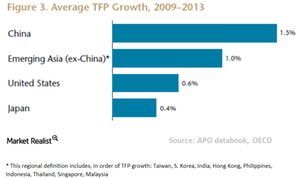What’s behind Asia’s High Total Factor Productivity Growth?
Total factor productivity measures increases in overall output due to technological advancement without an increase in inputs.
May 31 2017, Updated 1:35 p.m. ET

Matthews Asia
Total factor productivity (“TFP”): TFP captures all the contributors to an economy beyond the traditional measures of labor and investment. Examples of TFP in contemporary Asia include a shift from manual industrial production to robotics, the increased use of information technology, and the migration of workers to cities where their labor contributes more to GDP and where they find educational opportunities for their children.
Many economists believe that TFP may be the single biggest factor driving GDP growth. And TFP growth is notably high in Asia, influenced by supply-side reforms, market friendly policies, entrepreneurialism, technology and education.
Market Realist
Productivity rises
Total factor productivity measures increases in overall output due to technological advancement without an increase in inputs. The last three decades of high economic growth in Asia (MCHI) (EPI), particularly in East Asia, can be attributed to technological advancements in manufacturing industries and processing techniques. Rapid globalization after the 1980s helped these nations obtain advanced technologies from developed countries at a low cost, which boosted their export-led growth.
Asian economies’ success can also be attributed to governments’ reform agendas and policies, which tapped into the huge opportunities created by globalization. It’s no wonder many Asian nations now dominate global manufacturing (FXI).
Human capital
Another major factor that helps boost productivity growth is the number of skilled workers. Rising educational levels have significantly boosted productivity growth in Asia (AAXJ), excluding Japan, though it is still far lower than the average level seen in developed countries. As Asian economies (INDA) bridge the educational gap, they are expected to show even higher productivity growth.
Higher R&D (research and development) investment is another factor that enhances productivity. As shown in the chart above, East Asia’s R&D investments form a high percentage of its GDP, following North American nations closely.
